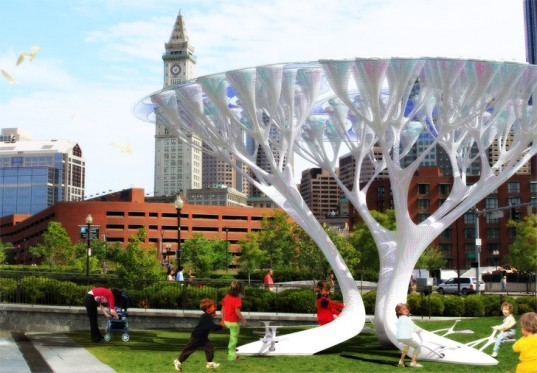It is dusk in Boston. Lights glow from apartment windows, and families wander down to the park to enjoy the end of day. Parents swing in hammocks under the trees and children play on the seesaws. As the sky darkens to night and the city lights appear, the trees in the park glow all the way from the trunk to the highest branches.
If you visit Boston in 2012, you may find parks like these where live trees have struggled and died, but Treepods, artificial trees made from plastic bottles, fill the void. Of course, the leaves don’t bud out in the spring or rustle in the wind, but a Treepod park provides a tranquil urban space, a social gathering spot, and most importantly, removes CO2 from the air—a critical function of real trees.
It was Klaus Lackner, a geophysicist at Columbia University, who discovered how to pull ambient CO2 out of the atmosphere and store it in a man-made resin material until it could be permanently sequestered. Inspired by Lackner’s discovery, a nonprofit firm wanted to introduce the CO2-absorbing technology to Boston and hired a Paris-based studio to design the project.
Naturally, the designers chose a tree as their model—the dragon’s blood tree from Yemen. Its broad umbrella-like top provides large swaths of shade, while the top branches are ideal for supporting the photovoltaic cells that power the tree. The seesaws and hammocks are a source of kinetic energy for the air filtration system and the interior lighting.
While the Treepods have generated excitement and been touted in the media as “sleek yet functional design pieces that would fit any urban environment,” Lackner’s goal was never to create urban furniture. He wanted to remove CO2 from the air on a large scale. He believes that people will not change their lifestyles in any significant way as long as fossil fuels are cheap and readily available, so he decided to deal with CO2 rather than look for new fuel sources.
Unlike the Parisian design, Lackner’s synthetic trees are the size of football goal posts with slats resembling Venetian blinds in between the posts. As the wind blows through, a coating on the slats absorb CO2 just as real trees absorb it through their leaves. Eventually it will be sequestered or sold to companies that use CO2. The prototypes have turned in some impressive results, absorbing CO2 1,000 times faster than a real tree and having the strength to hold 90 tons of CO2—the rough equivalent of annual emissions from 15,000 cars.
Once considered a fringe idea, artificial trees are now being taken seriously. As more people dedicate themselves to similar projects, Lackner predicts the costs will drop, making artificial trees a real option for reducing CO2 in the atmosphere.



